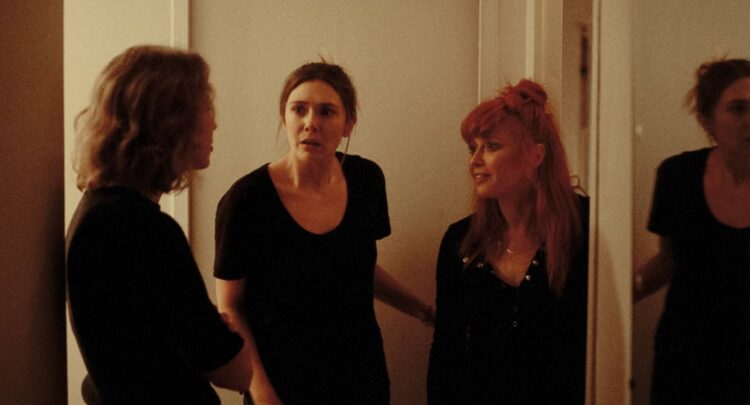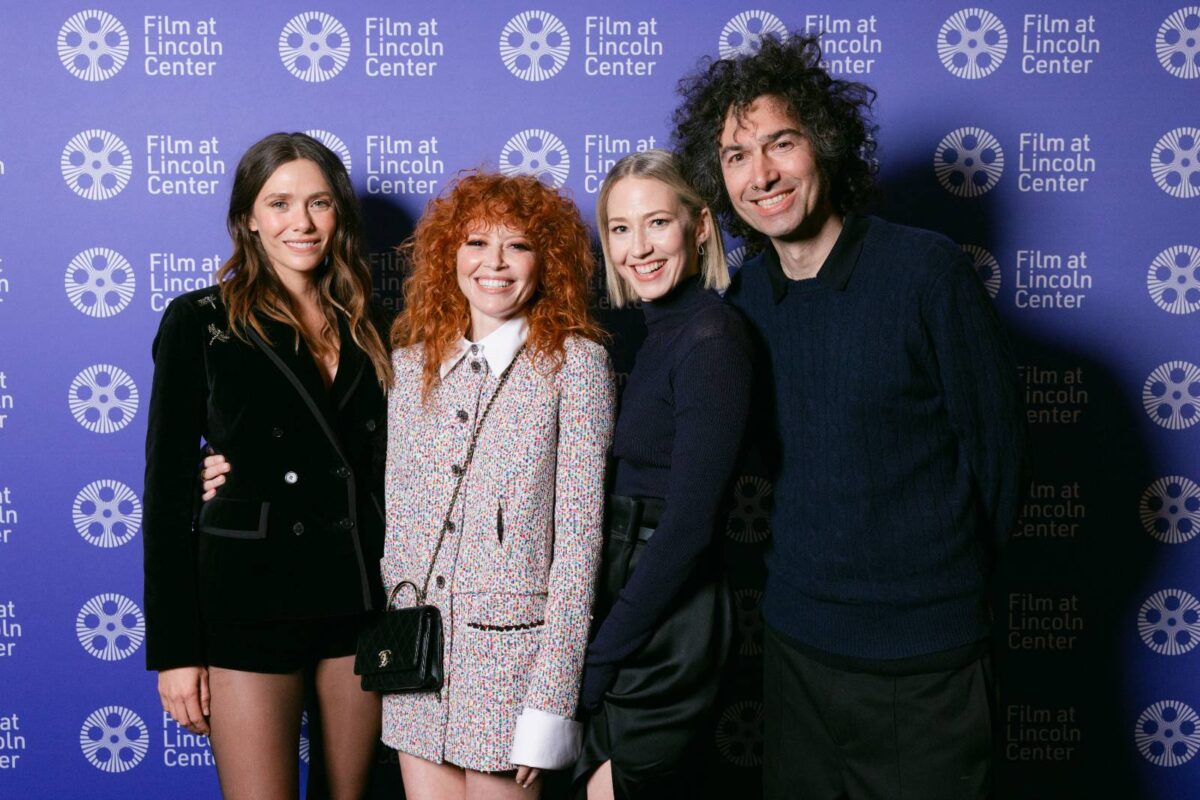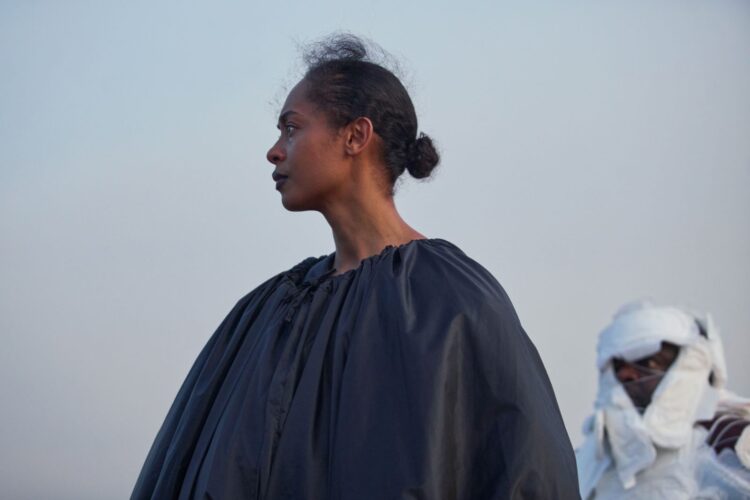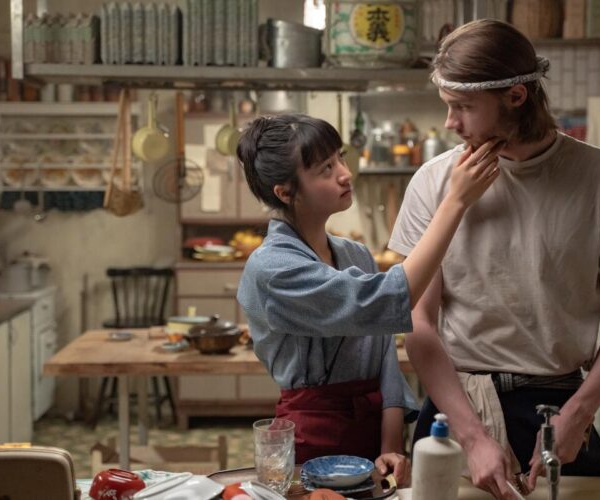

The most overwhelmingly emotional viewing experience I had at the Toronto International Film Festival last year, Azazel Jacobs’ tender, beautifully-acted drama His Three Daughters follows Carrie Coon, Natasha Lyonne, and Elizabeth Olsen as somewhat estranged siblings who reconvene in a small NYC apartment to process the final days of their father’s life. It’s a feat of both astounding performance and adept filmmaking. The way in which Jacobs brings dynamism to these close quarters is a site to behold. The drama arrives on Netflix this week.
Ahead of the release, I spoke with Jacobs about working with cinematographer Sam Levy, writing his unique characters, why he can’t film a dying scene, the reactions to the film, and how he decides his next projects.
The Film Stage: With this being mostly one location, I’m curious about your conversations with cinematographer Sam Levy. I love his 35mm work, and you both make this small location come alive. What were your discussions to sustain the momentum through the filmmaking?
Azazel Jacobs: I’ve been a fan of his for quite a while, a lot of different films, but it wasn’t until I saw Rothaniel. Did you see that stand-up that he did with Jerrod [Carmichael]?
Yes.
I was like, “I want that.” Again, I guess because of the one location, but there was a sense of a tone. I know it’s a collaborative thing, but it was beautifully lit, it was beautifully framed, and there was just a real sense of a person making choices. And so that was the thing that kind of tipped me over being like, “Oh, I’m going to go for Sam.” And we were able to start that conversation very, very early––I would say almost a year or so. It was nine months of prep. I went to him pretty soon after I went to the actors and started that conversation. About six months into it we started getting into talking about how we knew what this is going to be, before we even had the location. How do we talk about framing in the way that we would be revealing this home in the same level as we are revealing these characters? How to isolate not only characters, but how to isolate the apartment so that we really, truly wouldn’t know the connection from room to room in a way that we fully don’t understand the connection between a sister and a sister until later on.
We definitely would watch movies, but more than anything we just talked about how many angles that I could achieve the thing that I was trying to chase after, which was specifically how time is affected by knowing that death is coming. At least in my experience, it’s been a very strange effect where things get stretched out and elongated. So a lot of that conversation would be, “Okay, that takes a certain type of time compression and time elongation that’s not based on the real world, and how could we achieve that?”
Each of the daughters has their own kind of unique personality even though are all self-involved in their own ways. Elizabeth Olsen’s character genuinely loves her kid, but it also feels like she’s kind of overreaching to make her seem more ahead in her life than her sisters. I’m curious what inspired that character trait and how you fleshed out each character to seem not perhaps likable but relatable?
Well, I was very inspired by the theatrics of life. And I hear the comparisons to a stage play and I take that as a big compliment because that means that what’s happening, in terms of how things are shifting and how characters are shifting, is imperceptible––that it’s not really moving like real life. And so for me, thinking about going to these tremendous actors, knowing that, okay, we could start off with an archetype. We could start off with, okay, this is the Deadhead/wallflower, the middle-child situation with Lizzie. And then we’ve got the stoner and then we have the Type-A character and that we could unravel that. It was a way for me to jump right into it.
One of the reasons of not having any opening credits, no title beforehand––any kind of lead-up––is that we just jump into it in the most simplistic way. So that first line that Katie says, “You’ve been good, right?” and then she doesn’t let her answer. It’s just we get right into that. More than anything I was thinking: I don’t know about people in my own life, but just thinking about archetypes of people that I could then dismantle, especially if I was able to get the actress that I was writing for.

Photo by Arin Sang-urai, courtesy of Film at Lincoln Center
Speaking more to that, I imagine it’s beautifully written on the page, but as you did rehearsals and talk to the actors, were you taken aback about how it jumped alive? There’s so many nuances to each performance––where they pause or where they elongate a line, etc. How much did that evolve the project, or did you stick really close to the script?
That was a great thing, is: they all responded very strongly with this script. So we’re in agreement before even meeting up that it wasn’t about changing lines or anything like that. It was more about their different approaches to their character. So Lizzie, I went out to LA and spent a bunch of days just talking about people. I’m not a Deadhead, but I’ve known people that have found their ground, their community there. So we’ll talk about that. We talked about the idea of, you know, “I moved out of the city for many many years”––just what it means to leave the city and you don’t fully leave it. Like people, the whole time I was in L.A., thought I was still living in New York. I’d still be described as a New York filmmaker even though I was [in L.A.] for 20 years. And so that sense that no matter where you go, she still has that, but she’s still someplace else. And then Carrie was just like, “You’ll let me know if I’m doing something wrong.” All the answers are on the page. And Natasha was just her and I walking through the city and just kind of getting a sense of each other.
I would say that definitely, once we got into rehearsals––which was about four days of all of us together––and they were meeting for the first time and I was seeing them for the first time, is when all those things that you were saying started like. All I needed to do during rehearsal is just communicate the speed that I was looking for in terms of this very, very specific rhythm. But then it’s the mannerisms. It’s where Carrie looks, what that does. I had her looking straight at the camera, but what it actually means when Carrie’s opening up, looking straight––like a little bit above the camera––is a very, very different effect. You go, “Oh, okay this is her force of nature going through.” And also shooting in order, starting with that scene had this effect over the other actors, had this effect on the crew.
Then looking at Lizzie and the way she touches her neck or watches her sister when she drinks that first glass of wine and swallows––these are the things that you hope for, but they’re bringing in. And then I had a friend, Andy Lambert, say the other day after seeing the film, “Who would have thought that Natasha Lyonne was the best silent actress since 1927?” And it’s such a beautiful thing. It’s true. She’s an incredible silent actress. I see this history of film. The only thing that I can lay credit for is being there to capture and creating a situation that I was asking for that, but then actually capturing it, going into the edit room, that’s when I really [see it]. Because I’m shooting film, I’m not just staring at a monitor; I’m usually by the camera. It’s only when I’m in the edit room that I can see these things that you’re talking about, which are fully the little things that show these particular actors’ commitment to their craft which is just completely inhabiting.
I appreciated your decision to not show the father character until the end. I read you even played the heartbeat-monitor noises during the rehearsal so there was a sense of a presence there. How early in the process did you know you weren’t going to show him until the end? And did that help the writing, to make it more constrained and easier, or was it more of a challenge in the writing process to not have such a big character revealed until later?
It was really helpful because I knew that I did not feel comfortable shooting a dying scene. I’ve seen it done––we could talk about Amour or the Bob Fosse movie, All that Jazz. I mean, we could talk about it being done perfectly, right? And very honestly, I didn’t feel comfortable being able to reach that level. And so that decision of not going to the room and having an actor with makeup and all that stuff, that helped me out a lot. Feeling like, “Okay, I could pursue this story that’s really about sisters.” I will tell you that I did not ever expect the father to emerge. I wrote this one in order, scene one to scene two to scene three. And when I got to that place where the girls went into their father’s room and then suddenly I was writing that they were coming out with him, I was shook by it. I was totally like, “Oh, no, no, no, no, no, no. This was so elegant. This was such a simple, clean thing.”
But then it got me excited. It got me excited that suddenly I was breaking a rule that I had set. I always feel that every film was my last. And so then I was like, “Man, I’m just going to swing as hard as I can with this and it’s either going to live or fail with this.” I think it’s the biggest risk in the film and in some ways having it loom, because we’re shooting in order, over us was a really interesting effect. That no matter how composed you could get, no matter how in-sync we got, we had this big unknown factor towards the end coming, which was: “What is this going to be like with this new actor, this new presence? What is that feeling?” It shook me up and excited me.
I was going to ask you about another character, Jovan Adepo’s Benjy. He’s a bit like the audience surrogate in the sense that he’s the only one calling people out on their bullshit early into the movie. How important was it for you to pull back and get a bigger perspective than just the three daughters?
Yeah. I worked with him on Sorry for Your Loss with Lizzie. From that point on, we started texting and meeting and just kind of talking about making something together. So he was one of the people that I wrote for as well and printed out the script and sent it to. I sent it to the four of them, so he was essential. And then we met up at some point after he read the script to talk about it and it turns out that he had been a nurse and a caretaker, which was just kind of incredible that he was all of a sudden immediately was coming in from this deep understanding. He’s speaking in a way that I really wanted Rachel to. He’s speaking for us. He’s speaking for Rachel, and he’s defending and this thing about the apples that comes out. He is a brilliant actor that took this role as far and, I think, as rich as it could be.
I believe you get the full sense of their history, what his care for her is, and also his relationship to Vincent, which is also really important––that there was somebody that was connected to Rachel that would ask her to go in and we’d see that it’s not necessarily just her sisters that she doesn’t want to go in there. There’s something even bigger that she’s not ready to go into this room with him.
I saw this a year ago at TIFF and my dad actually passed away last year, so it was such an overwhelming viewing experience for me. Knowing this kind of emotional catharsis that comes at the end, when did you first realize what the reactions would be? Was it at TIFF or earlier? And have you been surprised by people’s reaction?
Surprised and moved. I cannot tell you how deeply I’m moved, especially lately––I’ve been getting people reaching out to say that they’ve reached out to family members, which is just one of those things that I couldn’t even hope for. That’s kind of amazing to have a direct effect in that way. Yeah, we finished really close to TIFF, and as I’m sure you know, one of the things that I wanted was no announcement before we started shooting. I wanted this film to exist once it existed. And that very first screening, I was sitting in the back with my wife, Diaz, who’s a producer on the film and my closest collaborator. And that whole experience was brand-new, just to see, to hear people laugh and then hear the quietness that came and the tears. I was astounded at the truth. It was completely astounding.
This experience for me has felt very, very lonely in a lot of ways and very, very confusing. And then suddenly it stopped feeling that way, that moment on. In an odd turn of events, I’m talking to you during this shift with my parents right now. And so it hasn’t ended. It’s been this strange parallel reality of this film and they both bleed into each other. And there’s one thing with this film: it has given me an increasing amount of comfort, the type of comfort that I’m hoping that the film gives an audience.
It feels like one of those movies that could be in the canon if someone’s trying to process grief, because it’s such a warm portrait as well as being emotional. And you really hit a lot of different emotional registers. It’s not strictly like Amour or something, as you mentioned. There’s just a lot of life to the movie, which is really beautiful.
Yeah. I’ve been thinking about the film lately, and I hope this doesn’t sound precious, but as a prayer. You know? Of me not so much trying to process––which I know I do––which I’m trying to imagine: what’s life after my parents? But just hope for a certain type of thing, just find some kind of joy and comfort in advance. Some type of security that I will have this to hold onto. You know, I made Momma’s Man because I realized, like, “Oh, this place that I grew up in, it’s a rental. It’s not going to be mine forever. I won’t be able to go back to it.” So making a film there was motivated by trying to hold onto the home for as long as I’m alive and hopefully the film would keep it alive in its own way, that part of New York. And that has felt similar in terms of this, which is keeping a certain feeling, a certain hope going past.
I’m always curious about filmmaker journeys and how much your new film would be a response to your last one. French Exit definitely had a different tone, a little more whimsical, definitely a very different visual style. How much do you think His Three Daughters was a response to do something kind of different? And as you look to a potential next project, are you looking to do something even more different?
Yeah. Yes, the answer is that I always try and go the opposite direction. The issue is that somebody had to cut together a montage of my work and you realize, when you see that, you made the same film over and over again. And so I want to tell you that I definitely am motivated to go in a different direction and I’m excited by these ideas that feel very freeing. I think the thing is: I don’t want to compare the work, I don’t want to, but they definitely inform each other. There were certain things that… the experiences, first off, like the pre-production of French Exit was so challenging putting together all these different production companies and figuring out the money, and all that stuff was so challenging that me putting together this film is clearly going: I’m going to [the production company] Arts & Sciences, I’m going to High Frequency [Entertainment], I’m going to Tango [Entertainment]. I did it in a very specific way because of how complicated [French Exit] was.
And then the other version was that I had this, like, six-month period where I was able to meet up with Michelle Pfieffer each week. And it was the first time that somebody had let me into their preparation process up-close. And I saw a master prepare. I went to a whole other type of schooling, sitting next to her and watching, “Oh, you can actually get that precise and it’s not, you know, messing with this pixie dust that we think occurs, but you actually can touch it and you can deal with it and you can think about it.” Because, you know, it terrified me. I thought that the magic happens when we’re shooting in that way, and if I hadn’t seen that type of incredible, beautiful work that Michelle Pfeiffer does when she approaches a role, there is no way that I would have been able to approach this story with the sense of vision and the sense of clarity that I did.
His Three Daughters arrives on Netflix on Friday, September 20.
The post His Three Daughters Director Azazel Jacobs on Emotional Catharsis, Why He Can’t Shoot a Dying Scene, and the Craft of Acting first appeared on The Film Stage.



